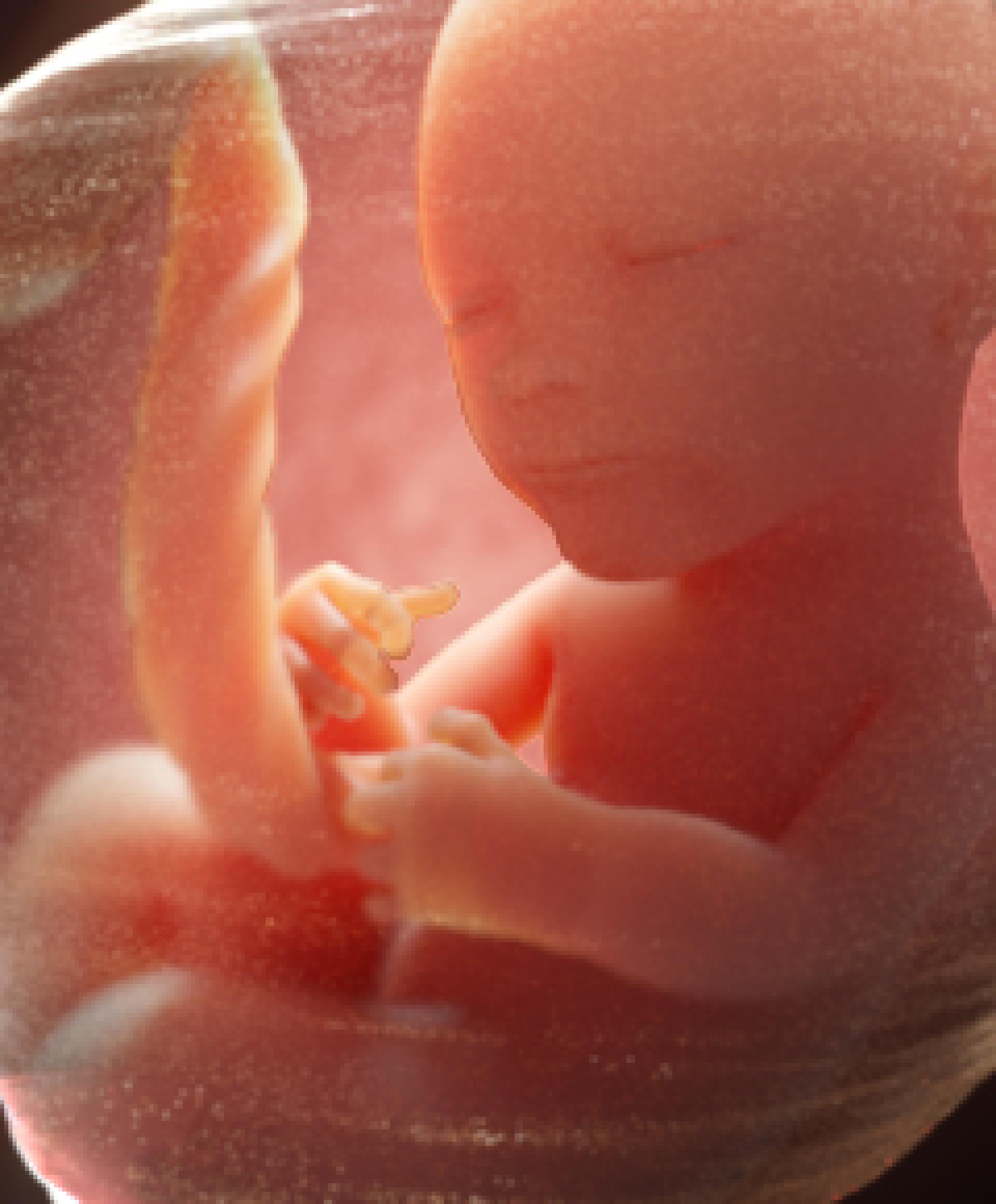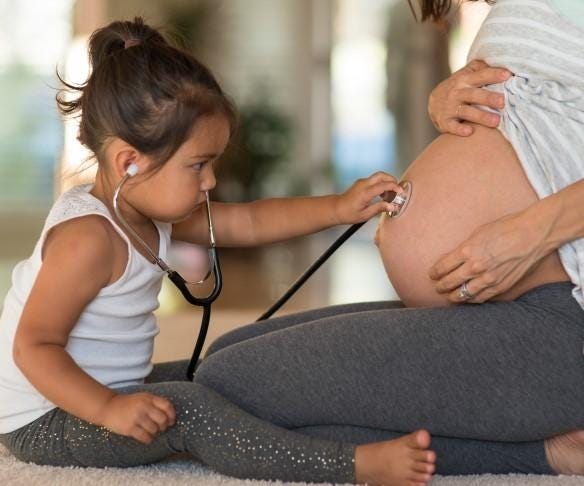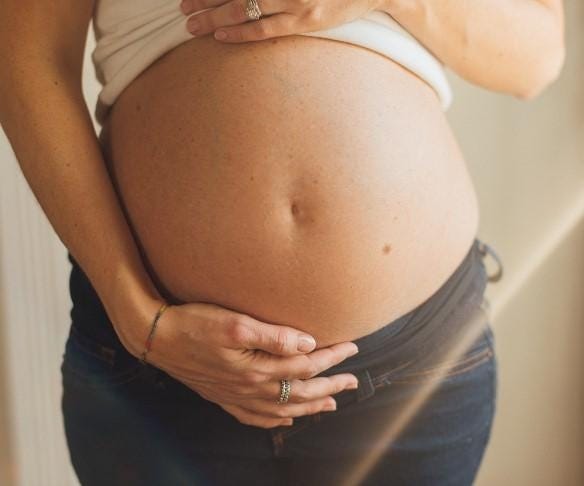
WEEK 27
Baby opens her eyes!
How baby grows
This week marks the beginning of your third trimester.
A big developmental change occurs as your baby's fused eyelids finally open. They’ve been closed since early pregnancy to protect the developing retina at the back of the eye. The retina develops its normal layers during this week.
Although your baby may not have grown much taller, she now weighs more than 2 pounds. She looks like she will at birth, just a little thinner and smaller.
Other developmental changes happening:
- Organs and systems. Lungs, liver, and immune system are still developing.
- Hearing. As hearing continues to develop, some scientists suggest your baby may start to recognize your voice, although sounds may be muffled because a waxy coating still covers the ears.
- Response to sound. This will become more pronounced as the development of the auditory nerve is completed.
- Brain. Her brain continues to grow and develop rapidly.
How you change
- Loose hips. As your uterus has grown and you've gained more weight, your ligaments get looser in preparation for delivery, which can make your hips feel unstable or loose. This loosening and shifting may cause occasional sharp pains in your pelvic area. It's important to move slowly and deliberately, and avoid sudden movements.
- Breathlessness. You may notice that it's getting increasingly hard to breathe as the uterus continues to expand near the rib cage, adding more pressure to your lungs. Getting a bit breathless is expected; but don’t worry, you and your baby are getting all the oxygen you need.
- Memory and concentration issues. Due to hormonal changes—and everything that's on your mind, you may have trouble concentrating, keeping track of belongings, or remembering important things. Help yourself to feel more in control by trying to minimize stress, getting plenty of rest, and taking these brief memory lapses in stride.
WEEK 28
Getting brainy
How baby grows
This week marks an important milestone for your baby's brain development. Until now the surface of your baby's developing brain was smooth. During this week, your baby’s brain is beginning to develop the folds and fissures of the human brain, giving it the characteristic wrinkled-walnut appearance.
At about 2 pounds 4 ounces and 13.8 inches from head to toe, your baby has certainly come a long way!
Other important advances:
- More fat. Your baby will continue to add layers of fat under her skin and will become plumper with each passing day.
- More hair. Hair on your baby's head will continue to grow.
- Testes. A boy's testes are usually completely descended into the scrotum by this point.
- Labia. A girl's labia are still small and won't yet cover the clitoris. The labia will grow closer together in the last few weeks of pregnancy.
- Lungs. Her lungs are now capable of breathing air.
How you change
- Weight gain. By week 28 your uterus is about 3 inches above your belly button. Your weight gain may range from about 17 to 24 pounds.
- Regular doctor visits. Starting now you'll probably be visiting your doctor every other week instead of every month. At your next appointment your doctor may be able to tell you how your baby is positioned in the womb.
- Your baby's position. Ideally, soon you will feel her settle with her head pointed down toward your cervix—a sensation called "lightening."
Good to know
A baby in a head-up or breech position during labor may need to be delivered by cesarean section if the doctor can't turn her around. However, don't be alarmed at a breech presentation at this point—it's not that unusual. She still has two months to change position, which most babies do.
WEEK 29
Get a kick out of this
How baby grows
Now that organ and nerve development are almost complete, your baby will start gaining weight very quickly—mostly in the form of body fat. This fat will provide insulation for your baby and will fill out most of the wrinkles in her skin, making her look like a plump, healthy infant.
Your baby's brain continues its important developmental work this week. In fact it is growing so quickly now, it may cause her flexible skull bones to swell slightly. The folds and fissures of the brain continue to develop, allowing room for important interconnections between nerve cells. During this week brain wave patterns begin to look like those of a full-term baby.
By this time your baby may weigh just under 3 pounds and is a bit less than 14 inches long.
Other important developments in the 29th week:
- Prolactin production. Your baby will begin to produce prolactin, a hormone that will help your body produce colostrum. Colostrum is the first breastmilk you'll produce and is filled with nutrients that help support a healthy immune system.
- Kicking. Insistent kicking action will occur as your baby's muscles develop. Later in this trimester these movements will slow down as she gets bigger and the uterus gets more cramped.
- Skeleton will continue to harden.
- Lungs will continue to mature.
- Loss of lanugo. Your little one's downy lanugo hair will begin to shed into the amniotic fluid. She may still have some on her body at birth, but this will fall off in the first week or so.
- Toenails will continue to grow.
- Retinas will continue to develop.
How you change
- Weight gain. Your overall weight gain may be 19 to 25 pounds.
- Nutritional needs. Your diet becomes even more important as your baby's nutritional needs peak. To keep your baby on track, you'll need plenty of protein, vitamin C, folic acid, iron and calcium. (About 200 milligrams of calcium is deposited into your baby's skeleton every day.) Dairy products, meat, fish, chicken, beans and tofu are good protein sources.
- Additional isolated pains. The normal side effects of pregnancy may peak now—itchy skin (a result of hormones and stretching skin), hemorrhoids, breathlessness, fatigue, aching muscles, heartburn and leg cramps.
- In the second and third trimester, leg cramps usually occur at night. Although their exact cause is unknown, they may be linked to fatigue, pressure of the uterus on the nerves in the legs and inadequate calcium intake.
WEEK 30
Whoops! Hiccups!
How baby grows
As practice for breathing after birth, your baby mimics breathing movements by repeatedly moving her diaphragm in a rhythmic way. This can trigger hiccups if she inadvertently inhales amniotic fluid. A pint and a half of amniotic fluid now surrounds your baby, but that volume decreases as she gets bigger and has less room in your uterus.
Your baby has probably reached 3 pounds and about 14 inches in length. She’s also filling out a bit as she continues to gain weight, and these layers of fat help her to appear less wrinkled.
Here's what else is happening this week:
- Head. Your baby’s head continues to grow, and brain growth speeds up even more.
- Hearing. It’s improving; nearly all babies can react by movement to sound by this week.
How you change
- Weight gain. At this point you may be gaining about a pound a week. Since the average weight gain during pregnancy ranges from 25 to 30 pounds, you may still have about 5 pounds to go.
- Vivid dreams. By now you might be dreaming more vividly. These dreams may be related to your concerns about the new baby, your parenting ability (especially if this is your first child), and how life will be changing for your family. It's normal to have recurrent dreams about childbirth or unexpected experiences with your baby.
- Trouble sleeping. If you're finding it hard to sleep at night, try taking a catnap during the day to make up for it. If you work during the day, find a break room or safe, quiet place where you can get a little rest.
WEEK 31
Your baby's eyes have it!
How baby grows
This week marks some major changes for your baby's eyes. Most notably, her iris will become pigmented. However, no matter what color eyes your baby is born with (most are born with dark blue-brown or blue-gray eyes), the color almost always changes after birth. Your baby's true eye color won't appear for six to nine months after delivery. That's because the final eye pigmentation occurs in response to the strong light of the outside world. Also, your baby can open and close her eyes while awake or asleep.
By the end of this week your baby will weigh about 3.5 pounds and will be about 14.5 inches long. From now on your baby's weight gain will exceed her growth in length.
Each day brings new developments inside the womb:
- Eyes. Your baby's eyes are now open during waking and are closed at naptimes.
- Lungs. Your baby's lungs and digestive tract continue to develop.
- Head-down position. As you near the end of the third trimester, your baby will begin to settle head-down into your pelvis. However, some babies don't make this journey until late in the last trimester, and about 4% of babies don't make the switch, remaining in a breech position at delivery.
How you change
- Aches and pains. Aches and pains are fairly common at this stage of your pregnancy.
- Enlarging abdomen. As baby grows bigger each day, your abdomen enlarges. You may experience a mild ache in your rib cage and pelvis.
- Swelling legs. You may experience additional swelling in your legs. Try to lie on your left side when sleeping or resting.
- When sitting you may want to tuck your legs to the side instead of in a crossed position because crossing your legs at the knee or at the ankle restricts blood flow to your legs.
- Heartburn. You may experience even more heartburn this week as your uterus presses against your internal organs. You can relieve heartburn by remaining upright after eating, and by eating smaller, more frequent meals.
- Leaking breasts. Some women begin to notice colostrum leaking from their breasts. If you’re experiencing this, you may want to use breast pads, which can help protect your clothes.
- Continued hormone production. During this time your body continues to produce a number of hormones in preparation for labor and delivery.
Top tip
Loose-fitting clothing is also a good idea so you don't restrict blood flow in your arms and legs. Tight clothing at the waist, knees, ankles, shoulders, elbows, or wrists can cause problems.





